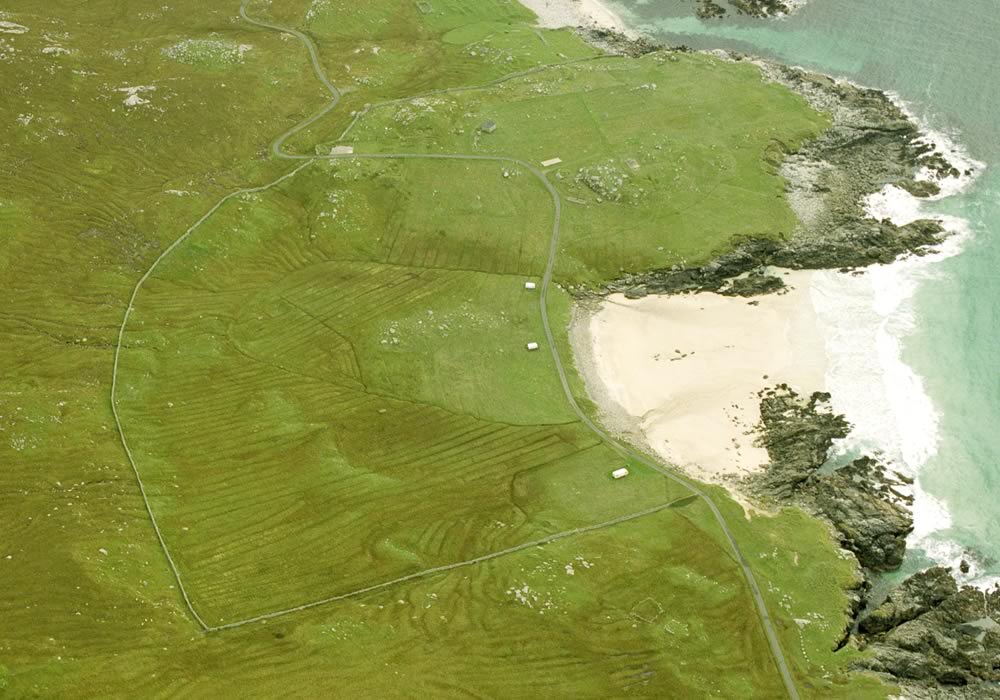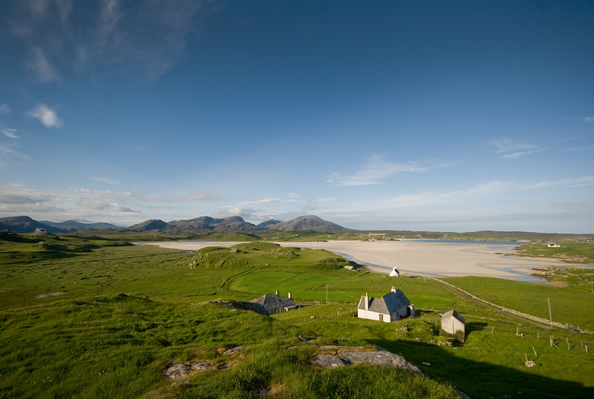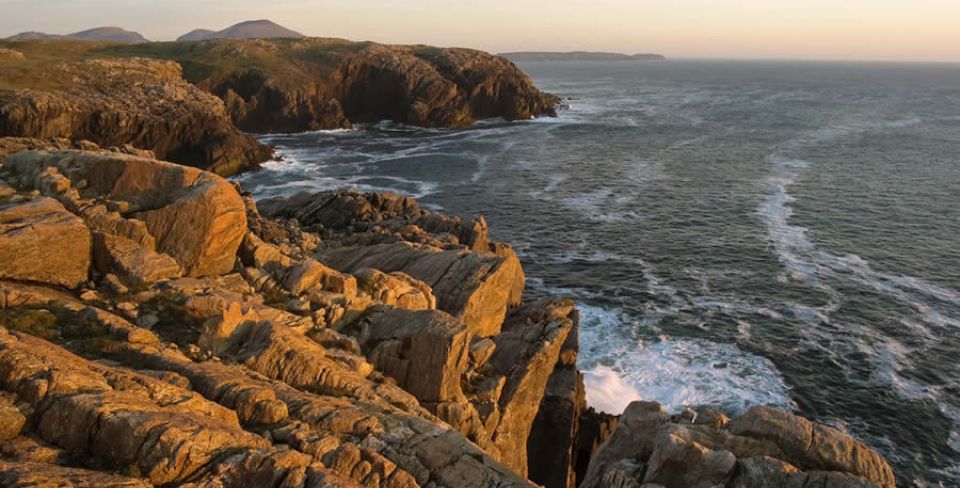9.4 Uig Peninsula, Isle of Lewis
Taigh a’Bheannaich, Gallan Head, Aird, Uig
The name of this chapel translates as ‘House of the Blessed or the Benediction’. It’s unusual because it is not dedicated to an individual saint. Unlike many of the other locations on this trail, the chapel is high on a cliff rather than being close to a beach or directly accessible by boat.
Taigh a’Bheannaich is still enclosed by the remains of a wall and the remains of 5 small monastic cells can be found nearby – archaeologists have also found traces of another 13 cells on this site.
The walls of the chapel are just over 1 metre high. The interior measures 5.5 metres by 3.3 metres.
Mealasta ruined nunnery and crofting township
The ruined crofting township of Mealasta dates from the 17th century although people lived here for many centuries before then.
Local tradition says that this was the site of a nunnery called Taigh nan Cailleachan Dubha – House of the Black Women or Nuns. The ruins of an early church and graveyard are close to the sea.

The crofting township of Mealasta was typical of many in these islands and was unchanged for centuries. The people lived on the resources of the land and the sea. They made fires from peat cut from the bogs in summer and dried in the wind. They grew crops in the machair land behind the beach. They fished.
The name Mealasta – and other names in this area – are Norse and reflect the Viking raids and settlements here.
The township was cleared for sheep farming in 1838 and local people moved to Ness in the north of Lewis or emigrated to Canada and Australia.
You can still see remains of the Second World War radar station that was here between 1941-1946.

What else?
It is worth heading to the Uig Peninsula not only for the sites relating to early Christianity but also for the stunning beaches of Uig and Mangarstadh.
The Lewis Chessmen were discovered on the beach at Uig. Find out more about the Lewis Chessmen and the history of Uig beach here.
For more local history, visit the Comunn Eachdraidh Uig website.
Outer Hebrides
- 9.1 St Columba’s Church, Isle of Lewis
This late 14th century church - named after St Columba - was later extended in the 15th and 16th century. St Columba’s was the principal church on Lewis in medieval times. It was built by the MacLeods and dedicated to Colmcille. Its importance may have been connected to its position...
- 9.2 St Moluag’s Chapel, Eoropie, Isle of Lewis
Eoropie township is on the northwest tip of the Isle of Lewis. It is the most northerly township in the Outer Hebrides. This restored chapel is dedicated to St Moluag or Moluoc. The building is flanked by two small side chapels to the north and south, creating a T-shaped outline....
- 9.3 St. John’s Chapel, Bragar, Isle of Lewis
Head west from the crofting township of Bragar to find the medieval chapel of Teampull Eoin - St John The Baptist - on a small headland next to the beach. The ruins of the chapel lie within a graveyard that is still in use today. The building was in two parts -...
- 9.4 Uig Peninsula, Isle of Lewis
Taigh a’Bheannaich, Gallan Head, Aird, Uig The name of this chapel translates as ‘House of the Blessed or the Benediction’. It’s unusual because it is not dedicated to an individual saint. Unlike many of the other locations on this trail, the chapel is high on a cliff rather than being...
- 9.7 St Clements, Rodel, Isle of Harris
This is the largest medieval church in the Outer Hebrides. Of all the churches in the islands, only Iona is larger. It was built in the 16th century but there is some suggestion that there may have been an older monastery on the site. The church was restored in 1873...
- 9.6 Northton Chapel, Toe Peninsula, South Harris
Northton Chapel faces south across the Sound of Harris looking towards the Uists. It sits on a small headland - Rubh’ an Teampull - at the foot of Ceapabhal hill. The chapel is in a stunning location and is reached by a 2.5km walk across grassland. The chapel is late...
- 9.5 Teampall Chaluim Chille, Eilean Chaluim Chille, Isle of Lewis
The small island of Eilean Chaluim Chille has probably been connected with Christianity since the 7th century. It sits on the eastern extremity of Loch Erisort as it leads out to the Minch. The remains of the church on the island probably date from the 12th century. Any earlier church...
- 9.8 Church of the Holy Trinity, Carnish, North Uist
Teampull na Trianaid (Church of the Holy Trinity) sits on a mound beside the village of Carinish. There are views west towards the low-lying island of Baleshare The remains of the Teampull na Trianaid dominate the site. There was probably a series of settlements on this site before the chapel...
- 9.9 Chapel of the Virgin Mary, Nuntown, Benbecula
The ruined medieval chapel sits in a graveyard which is still in use. The chapel was rectangular and would have had a pitched roof. The walls would have been much higher - you can see the top part of the door in the west wall. According to oral tradition, this...
- 9.10 Howmore, South Uist
The township of Tobha Mor - or Howmore - lies between the main North-South road on South Uist and the beach which forms much of the island’s west side. In among the thatched houses of Howmore are the ruins of a church and four chapels. Writing in 1703 in his...
- 9.11 Kilbar Church, Barra
Cill Bharra is the remains of a 12th century church dedicated to St Barr. The site is thought to have been used for Christian worship since the 600s when there was a chapel here dedicated to St Barr - probably the same saint as St Finbarr of Cork. Parts of...










Bòrd na Gàidhlig
Great Glen House
Leachkin Road
Inverness
Scotland, IV3 8NW
(+44) 01463 225454
colmcille@gaidhlig.scot
Colmcille
Foras na Gaeilge, 2-6 Queen Street
Belfast
Northern Ireland
BT1 6ED
(+44) 028 9089 0970
colmcille@forasnagaeilge.ie
Colmcille
Foras na Gaeilge, An Chrannóg
Na Doirí Beaga
Gaoth Dobhair
Donegal, Ireland. F92 EYT3
(+353) 074 9560113
colmcille@forasnagaeilge.ie


